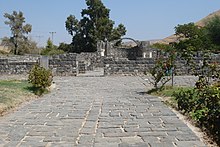Kursi, Sea of Galilee
The site is located near the eastern shore of the Sea of Galilee on the bank of a wadi, Nahal Samakh, descending from the Golan Heights.
Kursi has been identified by tradition as the site of the "Miracle of the Swine", where Jesus healed one or two men possessed by demons by driving these into a herd of pigs (Mark 5:1–20, Matthew 8:28–34, Luke 8:26–39).
This being a major pilgrimage site, a number of buildings were built for the accommodation of pilgrims as well as the local monastic community, all surrounded by walls and other fortifications.
metres in area,[1] and was entered through a forecourt opening onto an atrium or inner courtyard, followed by the church proper which was flanked on both sides by chapels and auxiliary rooms.
The mosaic floor of the nave consists of geometrical designs, while the lateral aisles once contained medallions with depictions of the local flora and fauna; most of these have been destroyed, but some are still visible, such as geese, doves, cormorants and fish,[1] citrons, dates, pomegranates, and grapes.
The baptistery chapel on the southern side of the central apse has a small baptismal font, and the mosaic floor includes an inscription indicating that it was laid in the year 585.
The ruins of the monastery were first unearthed by road construction crews in 1970, and the major excavation took place between 1971 and 1974 headed by Israeli archaeologist Dan Urman[6] and his Greek colleague Vassilios Tzaferis[1] for the Israel Antiquities Authority.
[7] They describe the inscription as being in Hebrew, at least 1,600 years old, and consisting of eight lines commemorating a man (or several) from Tiberias who has (or have) made a donation for the building that included marble.

